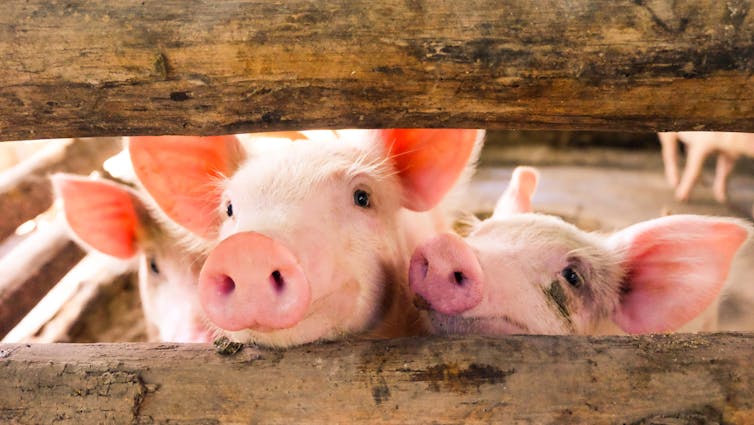Shutterstock
Rearing animals for food takes time and requires hard work to maintain their health and well-being. Just as in humans, farm animals sometimes get sick and require drugs to treat infections. But organisms that cause infections are becoming increasingly resistant to the available drugs. This antimicrobial resistance increases the more a drug is used, and when it is used inappropriately.
This misuse of antiobiotics is also having an impact on human health. We often think about antimicrobial resistance from the perspective of humans overusing antibiotics, but in fact it is a complex problem of many inter-related factors including animal health, the environment and food production.
Many of the bacteria observed in animals can cause disease in humans, and many antibiotics important for human health are also being used in animals. Resistant microorganisms can be passed on from animals to humans through direct contact, the food chain and the environment – for example, by fertilising crops with manure that then enters the water system.
Our research has shown that responsible antibiotics use in animal farming is complicated and while using fewer antibiotics is important, it is insufficient to control the growing problem of resistance. So what can be done?
Combating the threat
While such complexity creates many challenges, everyone can do their bit to tackle the problem of antimicrobial resistance. For example, people should only take antibiotics if prescribed, closely follow the instructions and never share or use leftover antibiotics.
Farmers and vets also have an important role in combating this global threat. There are many reasons why farmers might decide to use antibiotics. This includes therapeutic use to treat a bacterial infection in an animal, but also prophylactic use, where antibiotics are given in an absence of the disease to prevent potential infections from developing.
For example, when one animal gets an infection, prophylactic antibiotics might be given to the entire herd. While in certain circumstances this can be beneficial, such practices can be used inappropriately to compensate for increased risk of outbreaks resulting from intensive production practices, overcrowding and poor living conditions for animals.

Shutterstock
Another reason is to promote animal growth by supplementing their feed with antibiotics. While this may be economically beneficial for the farmer, helping to grow bigger animals faster, using antibiotics as growth promoters is considered to be inappropriate as it contributes to antimicrobial resistance.
The European parliament has approved legislation restricting prophylactic use of antibiotics in farming, which will come into force later in 2020. The use of growth-promoting drugs has been banned in Europe, the US and many other countries, but there are places, such as some Latin American countries, where these practices are still common. This creates potential risks to post-Brexit food production. While it is likely that the UK will continue supporting responsible use of antibiotics in farming, there are risks associated with opening up the UK market to animal products from countries with weaker regulations.
The scale of the challenge
Addressing antimicrobial resistance in livestock farming is challenging. When making decisions on whether or not to use antibiotics, farmers and vets should ideally do what is best for the animal, while reducing the risk of antimicrobial resistance. This means not using antibiotics prophylactically, using the right antibiotic at the right dose for the right duration for identified infections, but crucially, preventing these infections in the first place.
But reducing the use of antibiotics and applying measures to prevent the spread of infections could generate additional costs for farmers and result in higher food prices. Our research showed that there is no one solution and different strategies are needed to improve responsible use of antibiotics in different livestock sectors.
For example, one option would be to supplement vets’ education about responsible antibiotic-prescribing with infection-prevention practices to increase their trust in alternative strategies. Encouraging the use of diagnostic tests to confirm the presence or absence of infection could positively influence vets’ attitudes to reducing antibiotic use and improve their prescribing in cattle and pigs.
For farmers, improving management practices and animal husbandry is key – good housing conditions and cleanliness are paramount for all animals if they are to be healthy. But in addition, our research showed that where non-therapeutic use of antibiotics has been a particular problem in pigs, improving knowledge about antibiotic use and resistance could also be helpful. With cattle, strategies such as the use of alternative, non-antibiotic treatments or vaccinating herds could have a positive influence.
However, external pressures from governments or consumers were also identified as influencing factors. If demand increases for dairy, meat and poultry raised responsibly in terms of welfare and antibiotics, farmers and retailers will feel pressure to satisfy those needs and comply with guidelines and best practices. But this will require more resources and effort on the part of farmers, and may result in costs being passed on to consumers. So it is a price we must be willing to pay for healthier animals and safer food.
As members of the public with purchasing power, we all can play a role in improving antibiotic use in farming just as much as farmers and vets – a point worth remembering next time we consider our choices in the supermarket.
![]()
Lucyna Gozdzielewska received funding from Health Protection Scotland to conduct the research underpinning this article.
Lesley Price received funding from Health Protection Scotland to conduct the research underpinning this article.











